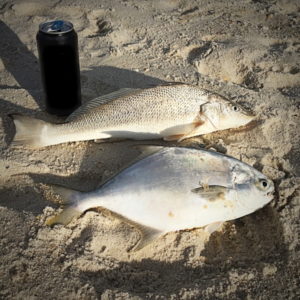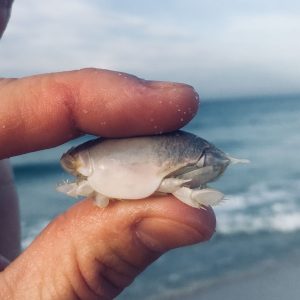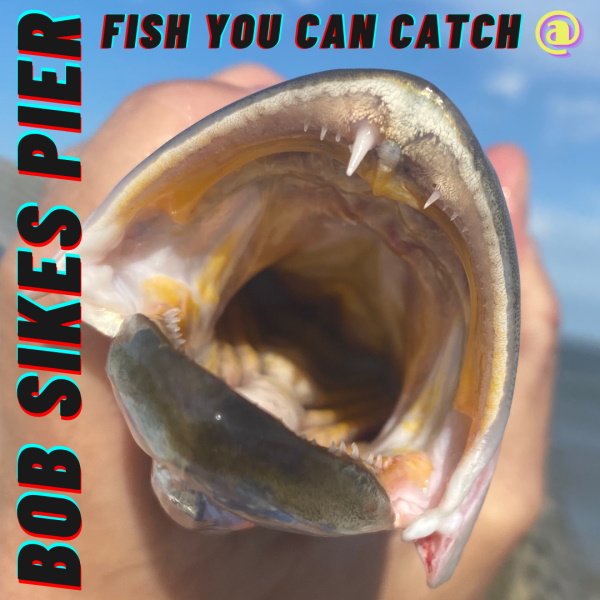
One of the greatest things about the Bob Sikes pier is the sheer number of different species that you might catch there.
You’ll likely encounter many of the common characters here, such as redfish, mangrove snapper, black drum, Spanish mackerel, and white trout, along with other lesser common bridge catches.
Find out below what other fish you might run across when fishing this very popular Pensacola fishing bridge.
1. Red Drum

Red drum are often at the top of the list of fish specifically targeted at Bob Sikes. They can be caught here year round, and day or night.
There are quite a few baits that are effective for redfish at the pier, some of their favorites being blue crab, mullet and menhaden. You can get these baits at the local bait shops or seafood markets in the area.
Send your bait down to the bottom using a fish finder rig. No need to cast very far out as they will likely be near the bridge pilings. You can also use lures to catch them, such as big curly tail grubs.
This is a great spot for catching bull reds, but just know that you cannot legally keep an over slot red drum in Florida. The slot is 18-27″ at the time of writing this article.
RED DRUM LIMIT: (1) per angler; 18-27″ slot size; no oversized fish
2. Sheepshead
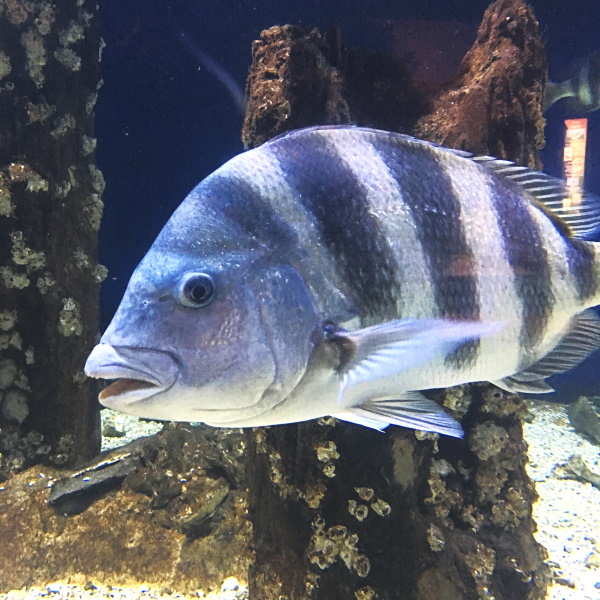
Sheepshead are predominantly a seasonal target on Bob Sikes, but they can also be caught outside the peak months of January through March.
To catch Bob Sikes sheepshead, use fiddler crabs or live shrimp, and put your bait as close to the bridge pilings as possible.
Actually hooking a sheepshead is a bit of a challenge, as they have tough mouths and are notorious bait stealers. Small but very strong bait hooks are helpful to penetrate their mouth. Sometimes it can seem as though you have to set the hook before you even feel the bite.
SHEEPSHEAD LIMIT: (8) per angler; 12″ minimum
3. Mangrove Snapper

These gray snapper are one of the top targets from this pier during the warm months. To catch mangrove snapper, send a live shrimp or small baitfish down on as light of a fish finder rig as you can use and still get the bait to the bottom.
GRAY SNAPPER LIMIT: (5) per angler; 10″ minimum size
4. Black Drum
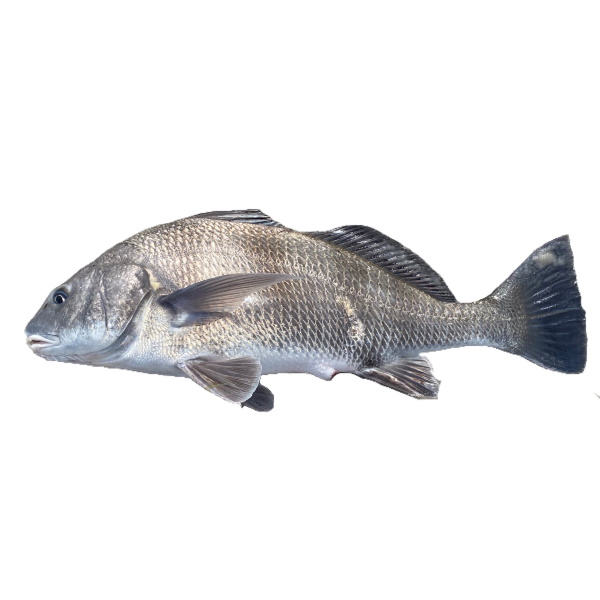
To catch black drum, drop a shrimp or crab to the bottom around the bridge pilings.
Although 1 jumbo sized black drum is allowed in your limit, I wouldn’t recommend keeping them. The smaller ones are much better tasting.
BLACK DRUM LIMIT: (5) per angler; 14-24″ slot size; (1) oversized allowed
5. Flounder

Although you can catch flounder here by bouncing jigs along the bottom, you’ll have more consistent success with using live shrimp or bull minnows fished on bottom.
FLOUNDER LIMIT: (5) per angler; 14″ minimum size; check for season close dates
6. Spanish Mackerel

Spanish are a common catch from the bridge in the summertime. They will make their way through here in the warm months, beginning about May. Sometimes you can catch quite a few out there.
There are several ways that you can catch Spanish when they are around. Freelining live shrimp, or baitfish, such as LY’s and whitebaits, away from the pier can be deadly. Bring a castnet to try to catch fresh live baits right from the pier. You can also float those same baits out under a bobber with 2 to 6 feet of leader under it.
Spanish mackerel can also be caught on lures such as the very popular Gotcha jigs. I like the chart/white color the best.
Be sure to use a strong leader when targeting Spanish as they will bite through light lines. If using wire and you are not quite getting the bites you expect, change over to a strong 30 lb. mono or fluoro leader instead. Long shank J hooks can also help minimize cutoffs when using non-wire leader.
SPANISH MACKEREL LIMIT: (15) per angler; 12″ minimum length to fork
7. Speckled Trout

Although spotted sea trout are best targeted elsewhere on grass flats, you can certainly catch them from the bridge. To catch speckled trout when they are around, use a live shrimp or small baitfish. You can also catch them on lures such as mirrolures and jigs.
SPECKLED TROUT LIMIT: (3) per angler; 15-19″ slot; 1 allowed over slot
8. Spadefish

While not exactly at the top of everyone’s most desired list, spadefish can be caught from the bridge. I have not eaten one myself, but I’m told that many folks actually like to eat them. Most of the ones you catch here will be on the smaller side. They have small mouths so you’ll catch them more often when using small bait and small hooks.
SPADEFISH LIMIT: *unregulated
9. Pompano

Certainly not as dependable here as some of the other species, Florida pompano can and will be caught from the Bob Sikes pier. If you want to specifically target pompano, you are better off heading to the beach.
POMPANO LIMIT: (6) per angler; 11″ minimum fork length
10. White Trout
White trout, or sand trout, provide much needed action in the colder months. Use shrimp or cut bait to entice bites. Some people like to eat them, but they can run pretty small. They can actually be used as bait to catch larger species such as red drum.
WHITE TROUT LIMIT: *unregulated
11. Stingrays
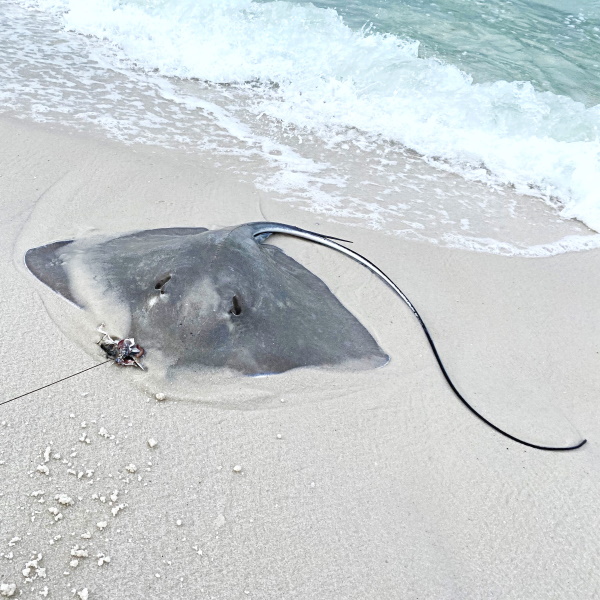
Stingrays are quite common in the area and it’s very possible that you could catch one or more. Smaller ones can be hoisted over the rail with your rod. However, bigger ones can be very heavy and will have to be pulled up with a pier net.
If you’ve never caught a stingray, the first few are fun, but you’ll likely prefer to avoid them after that. The bigger ones pull pretty hard and hug the bottom making it difficult to get them in which can be exciting, especially for newer anglers. Be very careful unhooking a stingray and releasing them so that you don’t get stung by the barb.
SOUTHERN STINGRAY LIMIT: *unregulated
12. Sharks
Specifically targeting sharks is better left for the beach in my opinion, but you will certainly catch smaller ones here even if you aren’t after them. Just watch those teeth when you are unhooking them.
SHARK LIMIT: Shark limits are complicated; Many species are protected; You really need to know what you are doing before keeping any shark species
13. Ladyfish

Unless you want them for cut bait, ladyfish are not something most anglers deliberately target since they are not really all that edible. If you fish the pier very much you will eventually run across a school of them.
You’ll end up catching ladyfish on all the same setups and lures that you use for Spanish mackerel. They are actually fun to catch since they fight hard for their size and often leap out of the water when hooked, kind of like a miniature tarpon.
LADYFISH LIMIT: *unregulated
14. Bluefish
Bluefish make their way through the area around the same time as Spanish. They won’t be as common of a catch as Spanish, but you can sometimes get on them.
Catching bluefish is a blast, as they are aggressive biters and fight hard for their size. This is another species whose teeth you have to watch out for when unhooking them. Because of those sharp teeth, sometimes you will need a tough mono leader to prevent bite-offs.
BLUEFISH LIMIT: (10) per angler; 12″ minimum fork length
15. Catfish
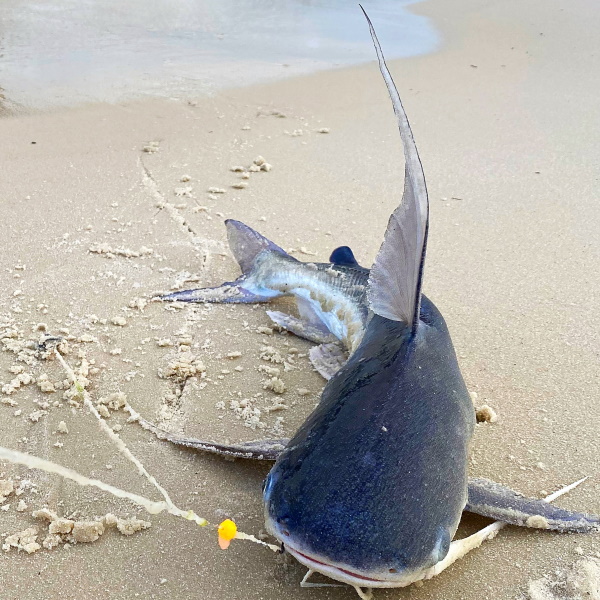
Not to be confused with it’s trashier cousin, the hardhead catfish, gafftops are actually good to eat. Notice the tall fin on top. That’s how you can immediately tell the difference between them and hardhead catfish.
CATFISH LIMIT: *unregulated
16. Pinfish
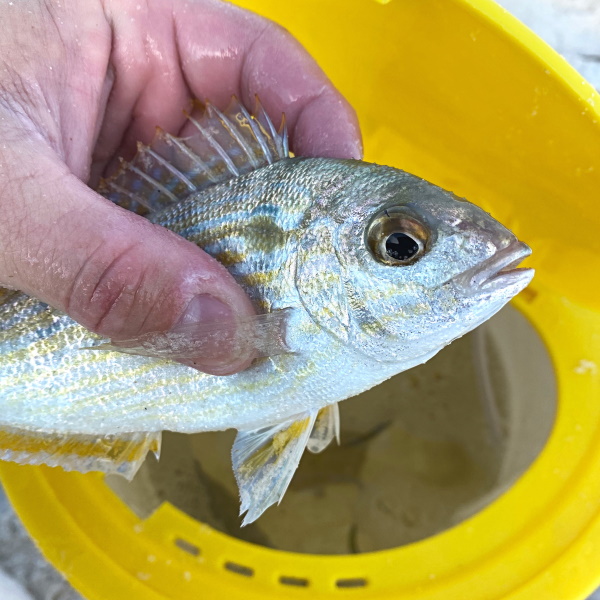
Pinfish make good bait for other bridge dwellers out there. If you catch larger pinfish, cut them up into chunk baits, or you can trim the dorsal fin off of smaller ones and cast those right back out as live baits for something bigger.
Pinfish chunks can be used for redfish, white trout or gray snapper. Small live ones are good for gray snapper, reds, and even flounder.
PINFISH LIMIT: *unregulated
17. Pigfish

Pigfish (Orthopristis chrysoptera) are very similar looking to pinfish. They are often referred to as “grunts”.
You’ll pretty much catch pigfish in the same ways that you catch pins. They are a trash fish that makes for pretty good cut bait, so you might want to keep a few.
PINFISH LIMIT: *unregulated
18. Croaker

If you catch a croaker (Micropogonias undulatus) this size or smaller, send that baby back down as live bait. Redfish and big specks will readily take a bait such as this. Small croaker are one of the best baits for big speckled trout.
CROAKER LIMIT: *unregulated
19. Cowfish
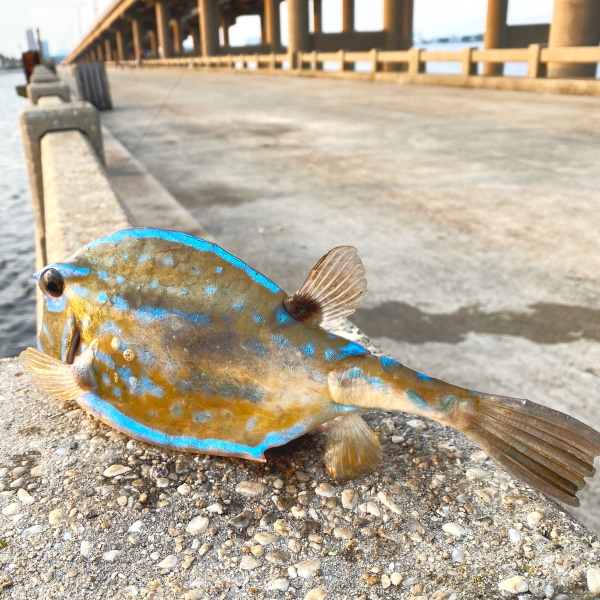
Cowfish are a cool tropical looking fish that you might pull up when fishing a sabiki rig or other small hook bait rig off the Bob Sikes bridge. With their super hard bony body, they are like a rock with fins.
Cowfish won’t necessarily be a common catch from the pier, but I included it in the list to show how you never know what kind of neat fish you could pull up on a given day.
They have tiny mouths, so you won’t be catching these on “normal” rigs. I caught 2 of these guys on sabiki rigs the last time I was out there.
20. Whiting
You won’t be specifically targeting whiting from this pier, but don’t be surprised if you hook one when fishing the bottom for other species. If you catch one of any size, keep it. They are very tasty.
WHITING LIMIT: *unregulated
Conclusion
As you can see, there are plenty of species to provide year round action on the Bob Sikes fishing bridge. There are other infrequent catches that could be added to this list, such as king mackerel, jacks, juvenile cobia, grouper, puffers, and others. However, the list above should cover most of what you can realistically expect to run into out there.
For a deadly straightforward approach, just tie on a Carolina rig with minimal weight and send a live shrimp to the bottom around the pilings. Use as light of a weight as you can that still gets your bait to the bottom. If the fish are biting at all, you are almost guaranteed to get in on the action with this setup.
For some extra fun, tie on a shrimp tipped sabiki rig while you wait on your bigger rod to go off. You might be surprised what you can pull up on those tiny bait rigs.
Note: For any *unregulated* species in Florida, there is a 2 fish or 100 lb. limit, depending on which one is greater. So, smaller fish have a limit of 100 lbs. no matter the number of fish it takes to get to 100 lbs. Larger fish are where the 2 fish limit comes into play when they add up to over 100 lbs. Hopefully that makes sense.
Good luck out there!
Augustus Clay


